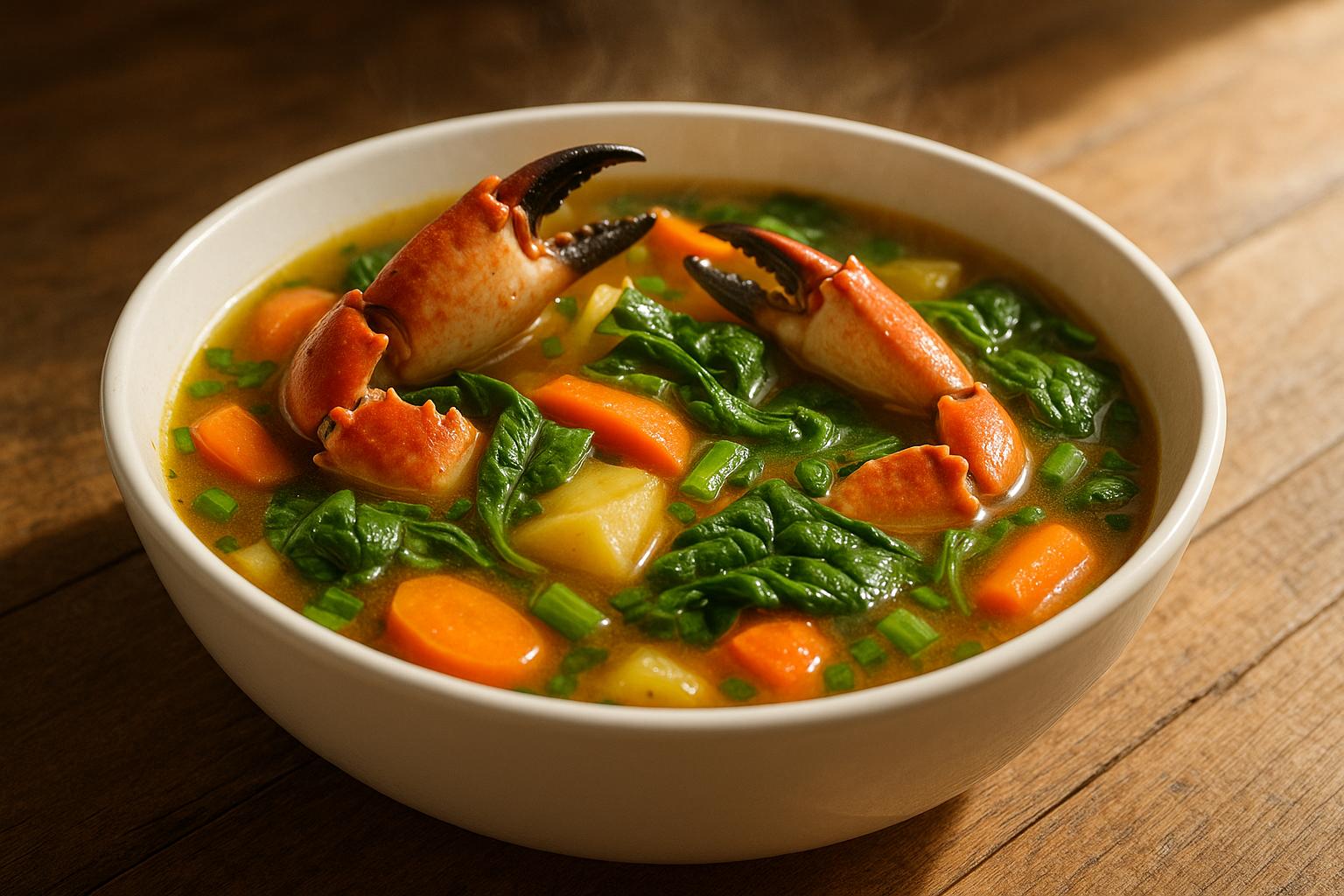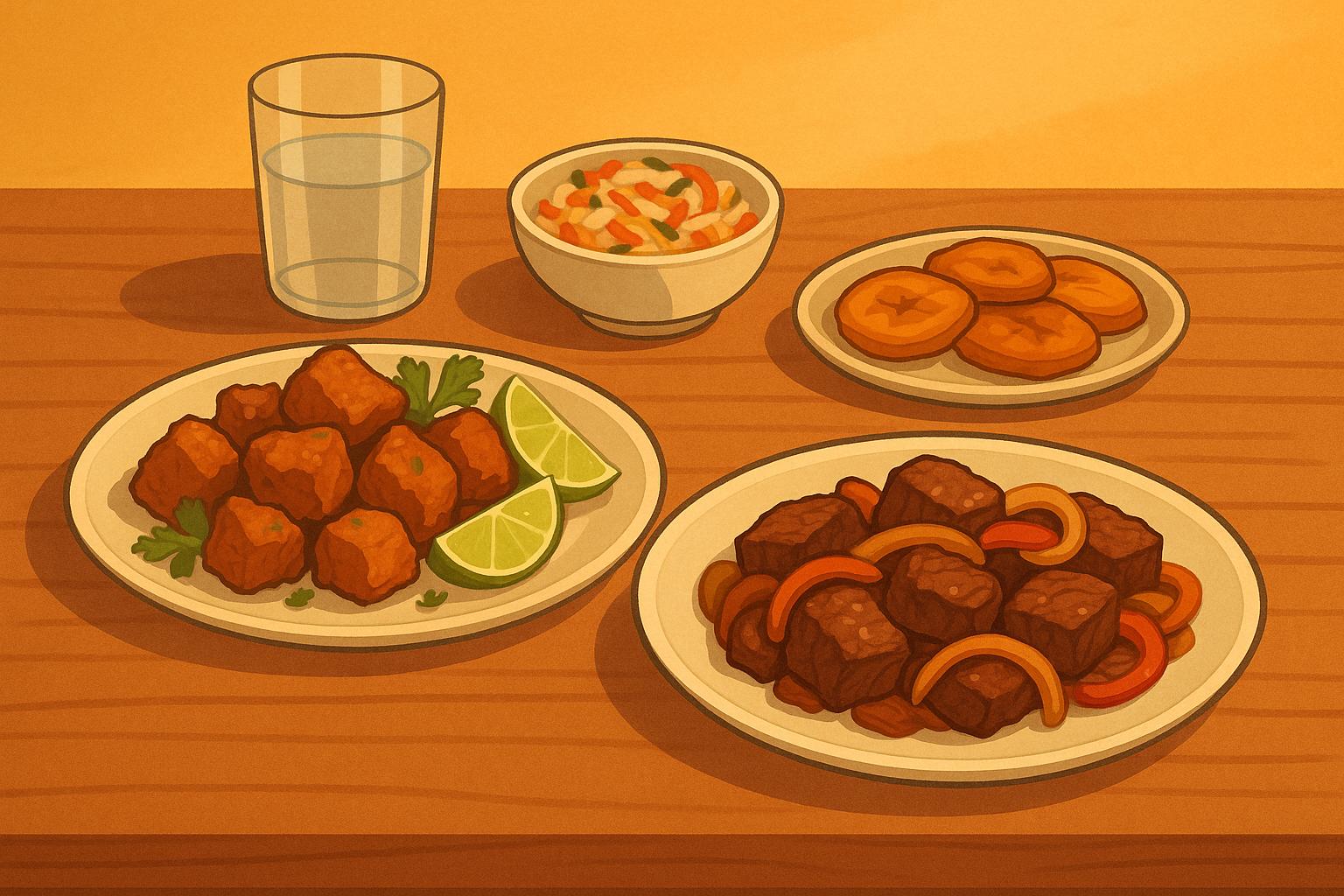Pikliz is a spicy, tangy pickled vegetable relish that’s a staple in Haitian cuisine. Made with shredded cabbage, carrots, Scotch bonnet peppers, and vinegar, it delivers bold heat and a refreshing crunch. Whether paired with fried pork, plantains, or rice dishes, Pikliz enhances flavors and balances rich meals.
Key Points:
- Main Ingredients: Cabbage, carrots, Scotch bonnet peppers, onions/shallots, vinegar, and spices.
- Preparation: Traditionally fermented for deep flavor or quickly pickled for immediate use.
- Uses: Complements fried and savory dishes, adds heat to modern meals like sandwiches and bowls.
- Storage: Properly stored Pikliz can last up to a year in the refrigerator.
- Where to Buy: Available online, in Caribbean markets, and Haitian restaurants.
Want to try it at home? Pikliz is easy to make and adds a unique, spicy twist to any dish.
Pikliz 🇭🇹- Haitian Spicy Slaw recipe - Easy pikliz recipe
Main Ingredients
The bold flavor and crisp texture of Pikliz come from a thoughtful mix of vegetables, peppers, and seasonings. Each ingredient contributes to the unique character of this beloved Haitian condiment.
Base Vegetables
At the heart of Pikliz are two key vegetables: cabbage and carrots. These form the foundation, providing both nutrition and a satisfying crunch. Finely shredded cabbage delivers a crisp texture while packing a nutritional punch - just 100 grams (about 3.5 oz) offers 44% of your daily Vitamin C needs and 72% of Vitamin K requirements. Carrots, on the other hand, bring a touch of natural sweetness, vibrant color, and essential vitamins.
"Pikliz (pronounced pick-lees) is a delicious, bright, crunchy, spicy slaw-like pickled condiment of cabbage, carrots, onions, and peppers in vinegar that is often eaten with meats and fried foods...because it helps to balance the flavor, and cuts through the fattiness of those foods." - Kate A, The Chopping Block
To round out the vegetable mix, shallots or onions are added. These aromatics deepen the flavor, complementing the other components perfectly. Interestingly, the fermentation process enhances the nutritional value of Pikliz, making it more than just a condiment. Next comes the element that gives Pikliz its signature kick.
Scotch Bonnet Peppers
The fiery personality of Pikliz comes from Scotch bonnet peppers, which add heat and a complex mix of sweet, fruity, and citrusy flavors. These peppers pack a punch, measuring between 100,000 and 350,000 Scoville Heat Units (SHU). While Scotch bonnets are the traditional choice, habanero peppers can be used as a substitute, offering a similar heat profile (100,000–250,000 SHU).
Here’s a quick comparison of the two:
| Pepper Type | Heat Level (SHU) | Flavor Notes |
|---|---|---|
| Scotch Bonnet | 100,000–350,000 | Sweet, fruity, citrusy |
| Habanero | 100,000–250,000 | Sweet, floral |
These peppers are not just about heat - they also contribute to the layered flavor that defines Pikliz.
Seasoning and Vinegar
The tangy backbone of Pikliz comes from a vinegar-based brine infused with thyme, cloves, peppercorns, salt, and lime juice. This mixture not only preserves the vegetables but also develops the condiment’s signature complexity over time. As Global Kitchen Travels notes, "The longer it is in the cabinet, the spicier it is going to get". Properly prepared, Pikliz can be stored for extended periods without refrigeration.
Some variations include additional elements for extra aroma or zest:
- Lime juice (a traditional choice)
- Sour orange juice (a regional twist)
- Optional additions like garlic or bell peppers
This blend of ingredients is sometimes referred to as the "Kimchi of the Caribbean", as each batch develops its own unique character depending on how long it’s aged and the precise ingredient ratios. This careful balance of flavors ensures Pikliz remains an essential part of Haitian cuisine, both as a condiment and a cultural icon.
Making Pikliz
Bring the vibrant flavors of Haiti into your kitchen by making Pikliz at home. Whether you prefer the traditional, slow-fermented version or need a quicker alternative, here's how to prepare this tangy, spicy condiment.
Basic Recipe Steps
The traditional method relies on natural fermentation for a bold, complex flavor:
-
Prepare the vegetables
Use fresh ingredients for the best results: 4 cups of thinly sliced green cabbage, 1 grated carrot, 1 sliced shallot, 1 bunch of scallions, and 1 yellow bell pepper. -
Add aromatics and seasonings
Mix in 5 minced garlic cloves, 3 sprigs of thyme, 1 tablespoon of black peppercorns, and 4 thinly sliced Scotch bonnet peppers. Adjust the heat level by removing the seeds if you prefer a milder kick. -
Create the pickling solution
Combine 4 cups of distilled white vinegar, ¼ cup of fresh lime juice, and 1 teaspoon of salt. This mixture preserves the vegetables and enhances their flavor.
Allow the mixture to ferment naturally for a deeper, more authentic taste.
30-Minute Version
If you're short on time, this method delivers Pikliz's signature tang and heat in a fraction of the time:
- Thinly slice all vegetables and pack them into a quart-sized mason jar.
- Prepare a pickling liquid by mixing raw cider vinegar, lime juice, salt, sugar, peppercorns, and cloves.
- Bring the liquid to a boil.
- Pour the hot mixture over the vegetables in the jar.
- Let the jar cool to room temperature.
You can enjoy this version right away, but letting it rest for 24 hours at room temperature allows for mild fermentation and a more developed flavor.
Proper Storage
No matter which method you use, proper storage is essential for maintaining Pikliz's quality and flavor.
| Storage Element | Recommendation | Purpose |
|---|---|---|
| Container Type | Glass mason jar | Prevents reactions with acidic ingredients |
| Temperature | Refrigerated | Keeps Pikliz fresh |
| Liquid Level | Vegetables fully submerged | Ensures proper preservation |
"The absolute freshness and bite of the sour spice of Pikliz is a unique flavor suited especially well for complementing oilier savory dishes. It's a good make-it-and-forget-it kind of side as long as you store it properly." - Noah Velush-Rogers
When refrigerated, Pikliz can last up to a year. Be sure to check periodically to ensure the vegetables remain submerged in the pickling liquid. If needed, top off with more vinegar. The flavor improves over time, with the best taste typically emerging after about 5 days of marinating.
sbb-itb-80c33ff
Serving Suggestions
Pikliz, with its bold heat and tangy kick, is a staple in Haitian cuisine, but it also shines in modern culinary creations. Its versatility makes it the perfect addition to both traditional dishes and contemporary meals.
Common Haitian Pairings
In Haitian cooking, Pikliz is a must-have alongside rich, flavorful dishes. Its acidity and spice balance out fried and hearty meals like griot and tasso, cutting through their richness effortlessly.
Rice-Based Dishes
A simple bowl of diri kole or diri djon-djon gets a flavorful boost with a spoonful of Pikliz, adding a spicy edge that enhances every bite.
| Traditional Dish | Pikliz's Role |
|---|---|
| Pwason ak bannann peze | Cuts through the fried fish and plantains |
| Kalalou | Brightens the flavors of the stew |
| Accra | Complements the crispy malanga fritters |
| Haitian Oxtail | Balances the richness of the beef broth |
"Pikliz represents the finishing touch of any Haitian dish... Something about the liquid, carrots, and cabbage just enhances the flavor of anything: fish, meat, soup, rice."
- Marie Dennery, Haitian-born home health aide
Modern Food Pairings
Pikliz isn't just for traditional meals - it has found a home in modern kitchens, especially among Caribbean fusion chefs who love its bold flavor and versatility.
Contemporary Pairings
- Breakfast: Add a spicy twist to avocado toast.
- Lunch: Use it as a topping for burgers or sandwiches.
- Dinner: Pair it with poke bowls or stir-fries for a unique flavor boost.
For those trying Pikliz for the first time, start with small amounts and adjust based on your spice tolerance. To mellow its heat, try these tips:
- Chill it in the refrigerator to soften the flavors.
- Use it sparingly with rich or heavy dishes.
- Pair it with cooling sides like avocado or rice to balance the spice.
Where to Buy Pikliz
Authentic Haitian Pikliz is now widely available across the United States. Whether you prefer browsing online or visiting local stores, there are plenty of options to get your hands on this spicy, flavorful condiment.
HaitianFoods.org Directory

HaitianFoods.org provides a detailed directory of Haitian restaurants and specialty food stores across the country. With its user-friendly search tools, you can easily locate places offering authentic Pikliz for takeout or retail. Just type in your location, and you'll find verified vendors nearby.
Featured Online Retailers
| Retailer | Product Size | Price | Shipping Info |
|---|---|---|---|
| Le Gouté Natural Spice | 32 oz | $28.88 | 1-2 business days |
| Sentaniz LLC | 16 oz | $14.99 | 3+ days (free shipping) |
| Prêt à Goûter Catering | 16 oz | $25.00 | Local pickup available |
While online shopping is convenient, exploring local stores gives you the chance to experience Pikliz firsthand.
"My goal is not to change the way you cook, but to enhance it!" - Samantha Benoit, Founder of Mumu's Pikliz
Haitian Restaurants Near You
If you're in South Florida, especially Miami's Little Haiti, you're in luck. This area offers a wide variety of authentic Pikliz. Many major U.S. cities are also catching on, making it easier to find this beloved Haitian staple.
Where to Look:
- Specialty Markets: Caribbean-focused supermarkets like Bravo and Presidente often stock several varieties of Pikliz.
- Major Retailers: Chains like Publix, Winn-Dixie, and some Walmart locations carry commercial brands such as Madame Gougousse.
- Local Vendors: Many Haitian restaurants sell their own house-made Pikliz, perfect for those seeking a more personal touch.
Take Piment Lacaye as an example. What started in 1995 as Cricilia Ladouceur’s homemade Pikliz sold from a Miami food truck has now grown into a household name, found in local supermarkets and restaurants.
"I have my Puerto Ricans, my Cubans, my Dominicans. They're all like: 'I need to have pikliz,' 'Pikliz with eggs, pikliz with spaghetti, pikliz with everything.'" - Cynthia Verna (Chef Thia)
These sources not only make Pikliz accessible but also celebrate the rich heritage of Haitian cuisine. Every jar reflects the bold flavors and traditions that make this condiment so special.
Tips for Choosing High-Quality Pikliz
When buying Pikliz, keep an eye out for these signs of freshness and quality:
- The vegetables should be clearly visible through the jar.
- Ingredients should be fully submerged in liquid.
- Vegetables should look fresh and crisp.
- Check the manufacturing date and storage instructions to ensure peak flavor.
With these tips in mind, you'll be ready to enjoy the vibrant taste of Pikliz wherever you are.
Summary
Bringing together the deep-rooted traditions and modern twists of Pikliz, this overview highlights its lasting influence on both culture and cuisine. Once a cherished homemade staple, this tangy and spicy condiment has grown into a widely loved addition, now easily found in major U.S. supermarkets.
What makes Pikliz stand out is its simplicity and adaptability. Made from basic ingredients, it serves as a perfect blend of practicality and heritage in Haitian cooking. As Elsy Dinvil aptly puts it:
"Pikliz transcends cultural backgrounds to throw a party in anyone's palate that eats it."
As discussed earlier, Pikliz seamlessly connects traditional recipes with modern fusion dishes. Whether cutting through the richness of fried foods or adding a kick to contemporary creations, it proves its ability to complement a variety of flavors.
The growing availability of Pikliz today mirrors its rich cultural origins while embracing modern production techniques. This evolution not only preserves its legacy but also broadens its appeal, cementing its role as a cornerstone of Haitian cuisine.
FAQs
How can I make Pikliz less spicy if I prefer milder flavors?
If you’re looking to dial back the heat in Pikliz, start by removing the seeds and white membranes from the Scotch bonnet peppers - these are where most of the heat is concentrated. Another option is to use fewer peppers or replace them with a milder variety, like jalapeños. To balance things out even more, you can increase the amount of cabbage and carrots in the mix or add extra vinegar or lime juice to tone down the spice. These tweaks will give you a gentler version of this zesty Haitian condiment while keeping its distinct tangy flavor intact.
What makes the fermentation process in Pikliz so beneficial?
The fermentation process in Pikliz does more than enhance its flavor - it also boosts its nutritional profile. By encouraging the growth of probiotics, it supports gut health and improves digestion. Fermented foods like Pikliz are also rich in B vitamins, antioxidants, and other nutrients that can help ease inflammation and bolster the immune system.
Another perk of fermentation is that it makes minerals more bioavailable, meaning your body can absorb them more easily. Beyond preserving the vegetables, this process turns Pikliz into a tangy, nutrient-packed condiment that complements countless dishes beautifully.
How can I use Pikliz to add a modern twist to dishes beyond traditional Haitian cuisine?
Pikliz is a bold and tangy condiment that can instantly elevate a variety of dishes. For example, try it as a topping for tacos - its spicy crunch works beautifully with grilled meats, fish, or even vegetarian options. Want to get creative? Add Pikliz to shrimp tacos for a lively blend of Haitian and Mexican flavors.
This zesty condiment also shines on sandwiches or burgers, where it cuts through rich ingredients like cheese or creamy sauces. Toss it into salads for a spicy, pickled kick, or use it as a garnish to brighten up grilled meats. Whether you're exploring new cuisines or adding excitement to everyday meals, Pikliz is a simple way to bring some heat and flavor to the table!


